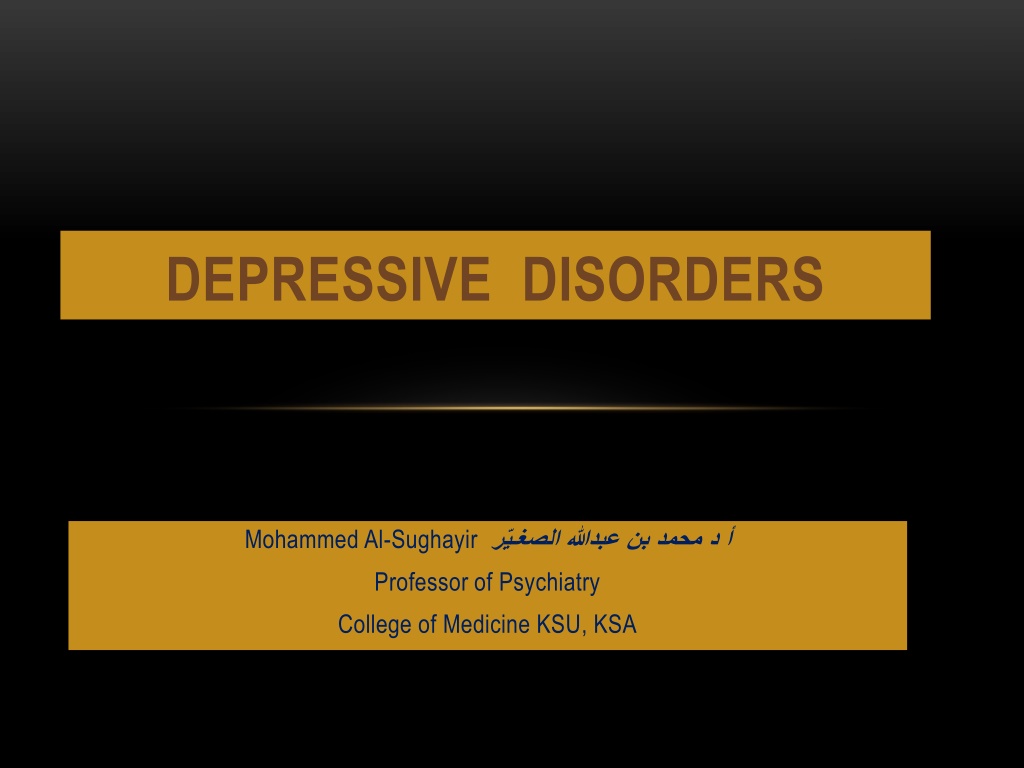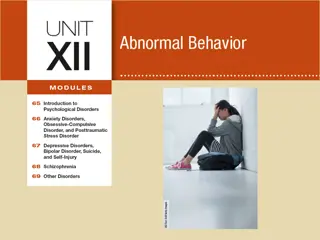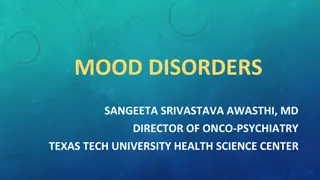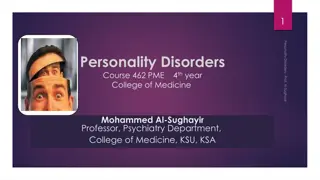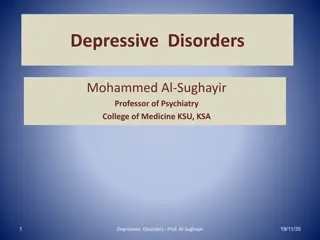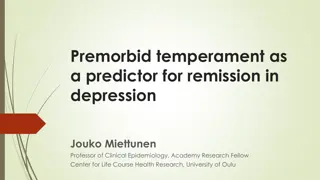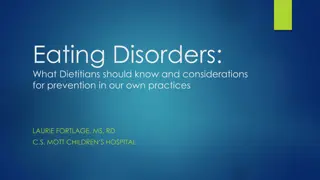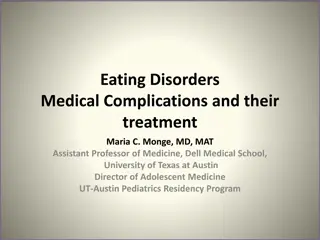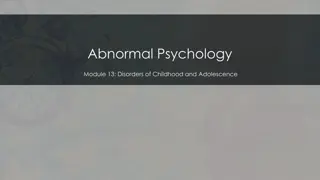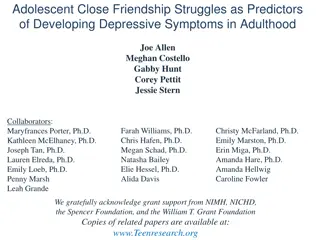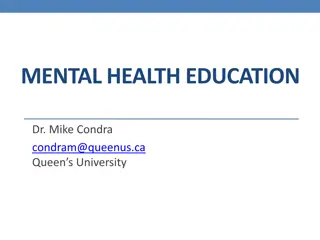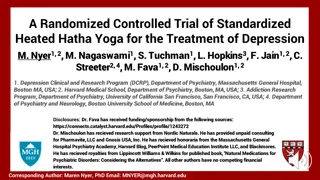Understanding Depressive Disorders by Professor Mohammed Al-Sughayir
This informative presentation by Professor Mohammed Al-Sughayir discusses the differences between usual sadness and depression, various types of depressive disorders, recognition of depressive disorders, etiology, complications, and treatment options. It includes a case study of a 27-year-old woman experiencing symptoms of depression and details depressive features related to mood changes, cognitive functions, and physiological signs.
Download Presentation

Please find below an Image/Link to download the presentation.
The content on the website is provided AS IS for your information and personal use only. It may not be sold, licensed, or shared on other websites without obtaining consent from the author. Download presentation by click this link. If you encounter any issues during the download, it is possible that the publisher has removed the file from their server.
E N D
Presentation Transcript
DEPRESSIVE DISORDERS Mohammed Al-Sughayir Professor of Psychiatry College of Medicine KSU, KSA
Objectives: To know the difference between the usual sadness and depression. To know that there are various types of depressive disorders. To be able to recognize depressive disorders. To know the etiology of depressive disorders. To know complications of depressive disorders. To know treatment of depressive disorders. DEPRESSIVE DISORDERS - PROF. AL-SUGHAYIR 2 -
Adjustment D. Metabolic-related Post-stroke Substance-related Side effect of Rx Depression Psychotic D. Mood disorders Depressive Disorders Major D. D. Dysthymic D. DEPRESSIVE DISORDERS - PROF. AL-SUGHAYIR 3 -
Ms. Amal is a 27-year-old single woman works as a teacher. She has a five-week history of low mood, chest tightness, poor appetite, disturbed sleep, excessive guilt feelings, and loss of interest in her social activities. What is the difference between usual sadness and depression? Healthy people have a wide continuum range of normal mood changes: . [ usual sadness < < < - - - ------------------------------------> > > usual happiness ]. Patients with depressive disorders have : - abnormal low mood / lack of pleasure/ physical features - Impaired social, and occupational functioning. DEPRESSIVE DISORDERS - PROF. AL-SUGHAYIR 4 -
DEPRESSIVE FEATURES: Mood Changes: Feeling low (more severe than ordinary sadness). Lack of enjoyment and inability to experience pleasure (anhedonia). Irritability /Frustration/Tension. DEPRESSIVE DISORDERS - PROF. AL-SUGHAYIR 5 -
DEPRESSIVE FEATURES: Cognitive Functions & Thinking: Subjective poor attention, concentration and memory. In elderly this may be mistaken as dementia (pseudo dementia). Depressive cognitive triad (pessimistic thoughts) as suggested by Beck; Present: patient sees the unhappy side of every event (discounts any success in life, no longer feels confident, sees himself as failure). Past: unjustifiable guilt feeling and self-blame. Future: gloomy preoccupations; hopelessness, helplessness, death wishes (may progress to suicidal ideation and attempt). DEPRESSIVE DISORDERS - PROF. AL-SUGHAYIR 6 -
DEPRESSIVE FEATURES: Change in sleep (usually reduced but in some patients increased). Early morning (terminal) insomnia; waking 2 - 3 hours before the usual time, this is usually associated with severe depression. Change in appetite (usually reduced but in some patients increased). Biological Features (Neuro-vegetative Signs): Change in weight (usually reduce but may be increased). Change in bowel habit (usually constipation). Fatigability, low energy level (simple task is an effort). Low libido and /or impotence. Change in menstrual cycle (amenorrhea). Several immunological abnormalities (e.g. low lymphocytes) increasing the risk to infection. DEPRESSIVE DISORDERS - PROF. AL-SUGHAYIR 7 -
DEPRESSIVE FEATURES; RANGE / ANALYSIS Appearance & Behavior: Facial appearance of sadness: down cast gaze/ tearful eyes / reduced rate of blinking. Head is inclined forwards. Psychomotor retardation (in some patients agitation occurs): Lack of motivation and initiation. Slow movements/slow interactions. Social isolation and withdrawal. Delay of tasks and decisions. DEPRESSIVE DISORDERS - PROF. AL-SUGHAYIR 8 -
Unipolar Mood D Presence of major depressive episodes only . Bipolar Mood D Presence of manic episodes(euphoria/grandiosity/over-activity) +/- depressive episodes. DEPRESSIVE DISORDERS - PROF. AL-SUGHAYIR 9 -
ETIOLOGY Psychological Biological: Genetic . Metabolic: e.g. Thyroid. Social CVA. Medications: long list of Rx. Autoimmune D. e.g. SLE. Cancer. Neurotransmitters involved in mood regulations: Low amount / activity of >>>>> Serotonin (5HT)- NA - DA DEPRESSIVE DISORDERS - PROF. AL- SUGHAYIR 10 -
Complications: Physical: increased risk of medical diseases e.g. CVA- MI-DM- HTN # Low adherence to Rx. Functional: deterioration in achievement (academic /occupational/ ) Social: isolation / financial difficulties/marital problems/ major poor decisions ) Suicide / homicide : Why?! DEPRESSIVE DISORDERS - PROF. AL-SUGHAYIR 11 -
EPIDEMIOLOGY Lifetime prevalence is in the range of 15 - 25 %. The mean age of onset is about 40 years (25 - 50 years). It may occur in any age group. In adolescents, it may be precipitated by substance abuse. DEPRESSIVE DISORDERS - PROF. AL-SUGHAYIR 12 -
POST-PARTUM DEPRESSION About 10 - 15 %. Within 6 weeks of childbirth (10 14 days after delivery). If not treated may continue for 6 months or more and cause considerable family disruption. It is associated with increasing age, mixed feelings about the baby, physical problems in the pregnancy and prenatal period, family distress and past psychiatric history. May be associated with irritability, self-blame and doubt of being a good mother, excessive anxiety about the baby s health and death wishes. Counseling, additional help with child-care may be needed. Antidepressants or ECT are indicated if there are biological features of depression. 13 DEPRESSIVE DISORDERS - PROF. AL-SUGHAYIR -
MANAGEMENT OF MAJOR DEPRESSION: Hospitalization is indicated for: Suicidal or homicidal patient. Patient with severe psychomotor retardation who is not eating or drinking (for ECT). Diagnostic purpose (observation, investigation ). Drug resistant cases (possible ECT). Severe depression with psychotic features (possible ECT). 14 DEPRESSIVE DISORDERS - PROF. AL-SUGHAYIR -
MEDICATIONS:ANTIDEPRESSANTS Antidepressants do not elevate mood in healthy people. May precipitate mood elevation in patients who have predisposing factors to mood disorders. They are usually commenced in small doses, which are then increased gradually (to reduce the risk of side effects). Antidepressant action may take 2-4 weeks to appear. Sudden withdrawal may lead to restlessness, insomnia, anxiety and nausea. They have to be continued for several months (six months is a usual period) after symptoms have been controlled, to avoid relapse. Some patients may require long treatment (years). DEPRESSIVE DISORDERS - PROF. AL-SUGHAYIR 15 -
SSRIS Uses: S/Es: GI upset. Headache/ irritability/sweating/fine tremor. Sexual dysfunction (delayed orgasm). Insomnia (mainly with Fluoxetine). Sedation (mainly with Fluvoxamine). Withdrawal syndrome (mainly with paroxetine). Depressive disorders. Other uses. DEPRESSIVE DISORDERS - PROF. AL-SUGHAYIR 16 -
SNRIS Venlafaxine(Efexor/Effexor) has a potential to induce higher rates of remission in depressed patients than do the SSRIs. This difference of the venlafaxine advantage is about 6 %. The most common adverse reactions are dry mouth, nausea, anorexia, somnolence, dizziness, nervousness, constipation, asthenia, anxiety, blurred vision, sexual. Sweating is also more common with venlafaxine than the SSRIs. Venlafaxine can cause an increase in diastolic BP, but this was seen more often in patients treated with doses of venlafaxine > 225 mg /day. DEPRESSIVE DISORDERS - PROF. AL-SUGHAYIR 17 -
PROGNOSIS OF UNIPOLAR DEPRESSIVE DISORDERS; About 25 % of patients have a recurrence within a year. About 10 % will eventually develop a manic episode. Be careful when commencing antidepressants, ask about past history of mania. A group of patients have chronic course with residual symptoms and significant social handicap. DEPRESSIVE DISORDERS - PROF. AL-SUGHAYIR 18 -
PERSISTENT DEPRESSIVE DISORDER Diagnostic Criteria 2 years history of chronic low mood. No remission periods more than 2 months. During low mood there should be 2 out of the following: 1. low energy or fatigue. 2. low self-esteem. 3. feeling of hopelessness. 4.insomnia (or hypersomnia). 5.poor appetite (or overeating). 6. poor concentration or difficulty in making decisions. DEPRESSIVE DISORDERS - PROF. AL-SUGHAYIR 19 -
The onset is usually insidious before age 25; the course is chronic. Some patients may consider early onset dysthymic disorder as part of life. Patients often suffer for years before seeking psychiatric help. About 25 percent never attain a complete recovery DEPRESSIVE DISORDERS - PROF. AL-SUGHAYIR 20 -
TREATMENT OF DYSTHYMIC DISORDER The most effective treatment is the combination of pharmacotherapy and cognitive or behavior therapy (CBT). A. Pharmacological: SSRI (e.g. fluoxetine 20 mg) SNRIs( e.g. venlafaxine 150 mg. These groups may be more beneficial than tricyclic drugs in the treatment of dysthymic disorders. B. Psychological: Cognitive therapy; to replace faulty negative self-image, negative attitudes about self, others, the world, and the future. Behavior therapy; to enable the patient to meet life challenges with a positive sense by altering personal behavior through implementing positive reinforcement. DEPRESSIVE DISORDERS - PROF. AL-SUGHAYIR 21 -
A 56-year-old hypertensive man on antihypertensive medications was referred to A 56-year-old hypertensive man on antihypertensive medications was referred to psychiatry clinic for evaluation of loss of pleasure, poor erection, poor appetite, and disturbed sleep. The most appropriate management step: a. Start him on paroxetine 50 mg. b. Investigate him for hypothyroidism. c. Review side effects of his medications. d. Add Propranolol to his medications.ranolol to his medications. DEPRESSIVE DISORDERS - PROF. AL-SUGHAYIR 22 -
Grief: sadness appropriate to a real loss. Despair ,sadness, weeping. Social withdrawal. Poor sleep & appetite Guilt toward the deceased. Experience of presence of the dead person. Somatic complaints with anxious mood. 23 DEPRESSIVE DISORDERS - PROF. AL-SUGHAYIR -
HELPING THE BEREAVED Normal process of grief should be explained and facilitated: help to overcome denial, encourage about the loss, and allow expressing feelings. Consider any practical problems: financial dependent children. Medications: anxiolytics for few days are helpful (when anxiety is severe and sleep is markedly interrupted). Antidepressants do not relieve the distress of normal grief and therefore should be restricted to pathological grief which meets criteria for depressive disorder. talking difficulties, caring for DEPRESSIVE DISORDERS - PROF. AL-SUGHAYIR 24
